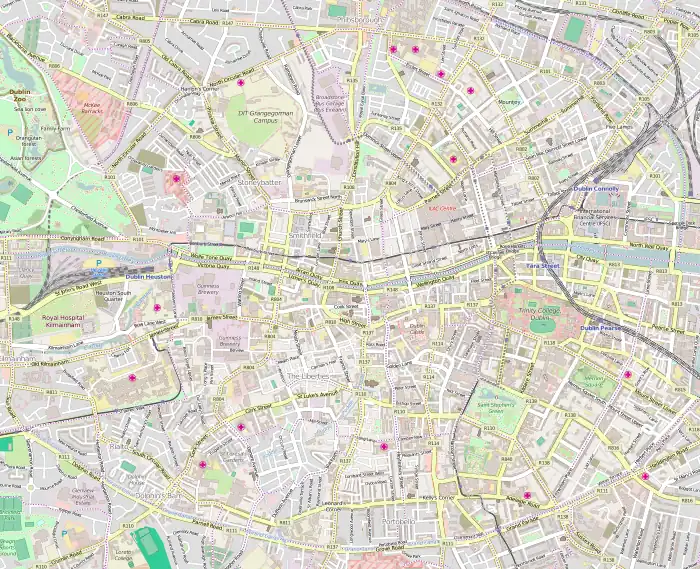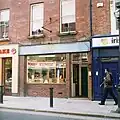Capel Street
Capel Street (/ˈkeɪpəl/ Irish: Sráid Chéipil[1]) is a predominantly commercial street in Dublin, Ireland laid out in the 17th century by Humphrey Jervis.[2][3]
 Clockwise from top: Capel Street near its intersection with Bolton Street; dining terraces outside restaurants and bars; along with Parnell Street, Capel Street is known for its Korean, Japanese, and Chinese eateries. | |
 | |
| Native name | Sráid Chéipil (Irish) |
|---|---|
| Namesake | Arthur Capell, 1st Earl of Essex |
| Length | 600 m (2,000 ft) |
| Width | 14 metres (46 ft) |
| Location | Dublin, Ireland |
| Postal code | D01 |
| Coordinates | 53.34843°N 6.26874°W |
| north end | Bolton Street |
| south end | Ormond Quay |
| Construction | |
| Completion | 1670s |
| Other | |
| Known for | restaurants, shops, cafés and pubs; immigrant community, LGBT community |
History

Capel Street takes its name from the nearby chapel of St Mary's Abbey (from the Latin Capella – Chapel) although Arthur Capell, 1st Earl of Essex, Lord Lieutenant of Ireland (1672–1677) may have also later influenced the naming convention.[4][5]
The street was laid out by Sir Humphrey Jervis in the late 17th century on the Abbey lands he purchased in 1674.[6] Jervis' own house was located at the corner of Mary Street and Capel Street and is described during the 1670s as 'the great mansion house of St Mary's Abbey'.[7]
He also developed Essex Bridge (today Grattan Bridge) connecting up his lands directly with the old city of Dublin and Dublin Castle thereby increasing the attractiveness of his estate North of the river.
The street was a busy thoroughfare known for its mansions. In the 18th century, it became a commercial hub, with two-bay buildings replacing most of the "Dutch Billy" houses.[8]
Today it is known for its variety of restaurants, shops, cafés and pubs; as Panti, the owner of Pantibar put it, "You can buy a lightbulb, sexual lubricant, Brazilian rice, get a pint and go to a trad session".
105 Capel Street, now the Outhouse LGBTQ+ Centre, is part of the original 14-bay terrace house built by Ralph Ward around 1770 and sits on the site of the former mansion of Thomas Connolly.[9]
Louis Copeland's tailor is another notable business on the street.[10][11][12]
On 20 May 2022, the street was pedestrianised.[13] It is now the longest traffic-free street in Dublin. [14]
Royal mint
In 1689, James II of England opened a royal mint in a large newly-built mansion at 27 Capel Street as well as another one at the Deanery in Limerick to make coins to fund his campaign to regain the throne.[15][16][17][18] The mint continued to make coinage after the Battle of the Boyne in 1690 and can be considered to be a descendant organisation to the modern Irish Mint.
Later the actor Thomas Sheridan was born in the same building in 1719.
Theatre
The Capel Street Theatre stood on the street in the 18th century. Later, the Torch Theatre also operated on Capel Street from 1935–41. In the late 1700s, the Italian composer, Tommaso Giordani, performed at a small purpose built theatre on the street.[19]
Architecture
The street affords a vista all the way from the junction with Bolton Street south through Parliament Street to Dublin's City Hall. Capel Street is notable for the remains of some "Dutch Billy" houses dating from the 18th century.[20][21]
In popular culture
Folk songs
- The Irish folk song "Waxies' Dargle", which originated as a 19th-century children's song, includes a section in which the protagonist visits a pawnbroking shop along Capel Street (a few of which remain to this day).
Gallery
 Berlin Optician, 157 Capel Street
Berlin Optician, 157 Capel Street Site of the Torch Theatre, 114–116 Capel Street
Site of the Torch Theatre, 114–116 Capel Street Slattery's Bar, 129 Capel Street
Slattery's Bar, 129 Capel Street.jpg.webp) Jack Nealon's pub, 165 Capel Street
Jack Nealon's pub, 165 Capel Street Outhouse, 105 Capel Street
Outhouse, 105 Capel Street King James II's Mint House, 27 Capel Street
King James II's Mint House, 27 Capel Street
See also
References
- "Sráid Chéipil– Placename database of Ireland". Retrieved 12 October 2021.
- "Lovin Dublin City Spotlight - Capel Street". LovinDublin.com.
- Greene, John C.; Clark, Gladys L. H. (9 February 1993). The Dublin Stage, 1720-1745: A Calendar of Plays, Entertainments, and Afterpieces. Lehigh University Press. ISBN 9780934223225 – via Google Books.
- M'Cready, C. T. (1987). Dublin street names dated and explained. Blackrock, Co. Dublin: Carraig. p. 18. ISBN 1-85068-005-1. OCLC 263974843.
- Maxwell, Nick (8 March 2013). "St Mary's Abbey". History Ireland. Retrieved 23 June 2023.
- Clerkin, Paul (2001). Dublin street names. Dublin: Gill & Macmillan. p. 25. ISBN 0-7171-3204-8. OCLC 48467800.
- "Capel Street ACA Final Document" (PDF). www.dublincity.ie. Retrieved 23 June 2023.
- Oram, Hugh. "Capital vision – An Irishman's Diary on Capel Street". The Irish Times.
- "Outhouse, 105 Capel Street, Dublin, DUBLIN". Buildings of Ireland. Retrieved 13 June 2023.
- "Capel Street: Why Dublin's black sheep is its most brilliant street". independent.
- "Dublin Uncovered: Capel Street".
- "The Capel Street Series #1". DublinTown. 27 August 2014.
- "Capel Street's traders remain at odds over its pedestrianisation". The Irish Times. Retrieved 18 July 2023.
- "Capel Street officially becomes longest traffic-free street in Dublin".
- "King James II's Mint House, 27 Capel Street, (now demolished) Birthplace of Actor Thomas Sheridan". onlinecollection.nationalgallery.ie. Retrieved 23 June 2023.
- Ruding, Rogers (1840). "Annals of the coinage of Great Britain and its dependencies: from the earliest period of authentic history of the reign of Victoria". Hearne. Retrieved 23 June 2023.
- Hopkins, Frank (11 February 2008). Hidden Dublin: Deadbeats, Dossers And Decent Skins. Mercier Press Ltd. ISBN 9781856357258. Retrieved 23 June 2023.
- "Early development". www.dublincivictrust.ie. Retrieved 23 June 2023.
- Maxwell, Constantia (1997). Dublin under the Georges : 1714-1830. Dublin: Lambay Books. p. 125. ISBN 0708944973. OCLC 1244738727.
- "Dublin's lost buildings: The Dutch Billy". irisharchaeology.ie. 10 March 2012. Retrieved 23 May 2022.
- McDonald, Frank (13 October 2011). "Dutch Billy 18th century houses at risk". The Irish Times. Retrieved 23 May 2022.